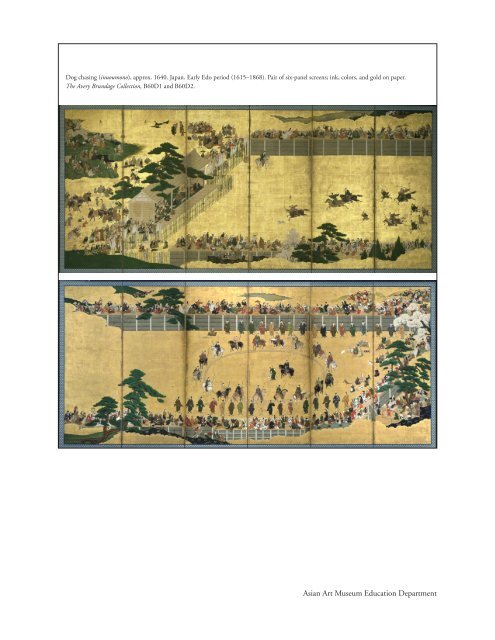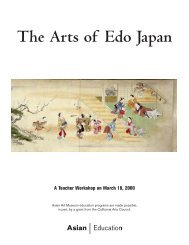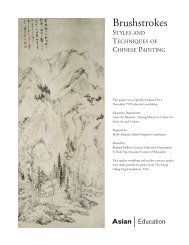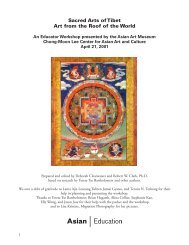Dog Chasing (PDF) - Asian Art Museum | Education
Dog Chasing (PDF) - Asian Art Museum | Education
Dog Chasing (PDF) - Asian Art Museum | Education
You also want an ePaper? Increase the reach of your titles
YUMPU automatically turns print PDFs into web optimized ePapers that Google loves.
<strong>Dog</strong> chasing (inuoumono), approx. 1640. Japan. Early Edo period (1615–1868). Pair of six-panel screens; ink, colors, and gold on paper.<br />
The Avery Brundage Collection, B60D1 and B60D2.<br />
<strong>Asian</strong> <strong>Art</strong> <strong>Museum</strong> <strong>Education</strong> Department
What activity is taking place<br />
here?<br />
<strong>Dog</strong> chasing was one of three<br />
archery drills popular during<br />
the Edo period (1615–1868).<br />
Originally an exercise to improve<br />
martial skills, it became a formal<br />
sport with defined rules as early as<br />
the fourteenth century.<br />
The right-hand screen represents<br />
an early stage of the game.<br />
Around a circle formed by a heavy <strong>Dog</strong> chasing (detail; B60D2).<br />
rope laid on the ground, archers<br />
wait for a dog to be released. The<br />
archers wear a special costume, which includes a hat, sword, and fur chaps. Two additional groups of<br />
seventeen archers each are lined up along the fence on either side of the field.<br />
The rules of the game stipulate that when the dog passes over the rope it may be shot with heavily<br />
padded arrows, only in the torso, with hits on the head or limbs counting as errors with penalty<br />
points. If the dog escapes without being hit, the archers may pursue it into the outer field, as shown<br />
in the left-hand screen. The archer’s skill and accuracy was judged according to the accuracy of his<br />
hits (each had three arrows) and the length of the ensuing chase.<br />
What is the relationship of this activity to samurai life? Who are the people watching the<br />
spectacle?<br />
By its very nature, dog chasing required great equestrian and archery skills, making it the domain of<br />
the samurai class. First mentioned in a historical account dating to the early thirteenth century, dog<br />
chasing gained importance in the Kamakura period (1185–1333) as a means of honing the skills of<br />
the newly dominant warrior class. It remained popular throughout the Muromachi period (1333–<br />
1568), but in the late sixteenth century, fewer dog chases were held as samurai became occupied with<br />
civil wars instead of martial sports.<br />
When peace returned and the Edo shogunate restored traditional festivals, the Shimazu clan<br />
of Satsuma Province organized a dog chasing event in 1646. The popularity of the game quickly<br />
revived, and it soon began to attract crowds of townspeople who regarded it as lively entertainment.<br />
In addition to samurai, the viewers’ stands in these screens are filled with spectators from all walks of<br />
life—housewives, children, monks, Shinto priests, nuns, and doctors.<br />
Who would have owned a screen like this?<br />
Given the subject matter and expense of this elaborate pair of gold-ground screens, the owner was<br />
likely to have been a wealthy samurai, perhaps a particular fan of the dog chasing event. By the seventeenth<br />
century when this screen was made, ritualized displays of martial prowess like dog chasing<br />
had come to replace real military experience for many samurai.<br />
<strong>Asian</strong> <strong>Art</strong> <strong>Museum</strong> <strong>Education</strong> Department
















